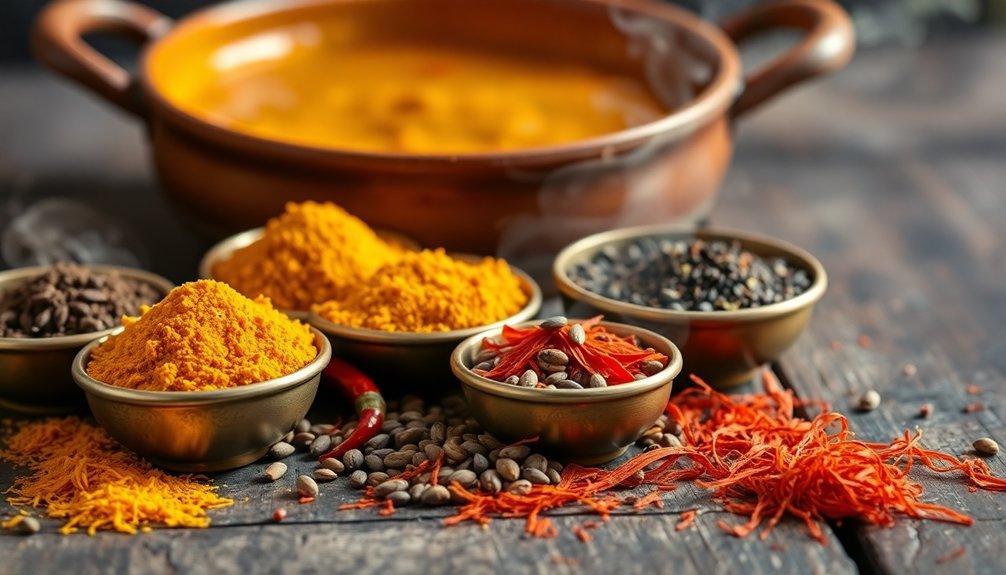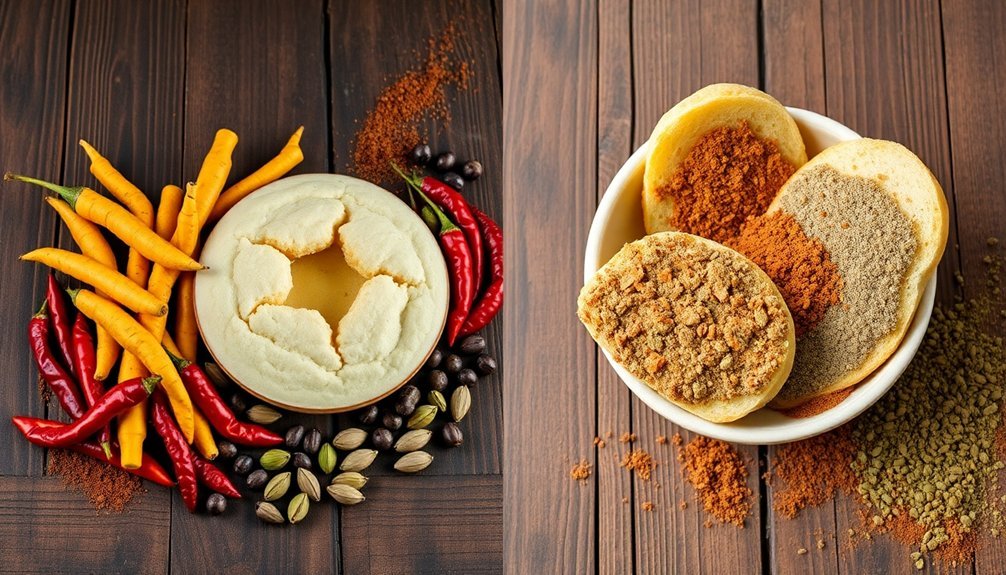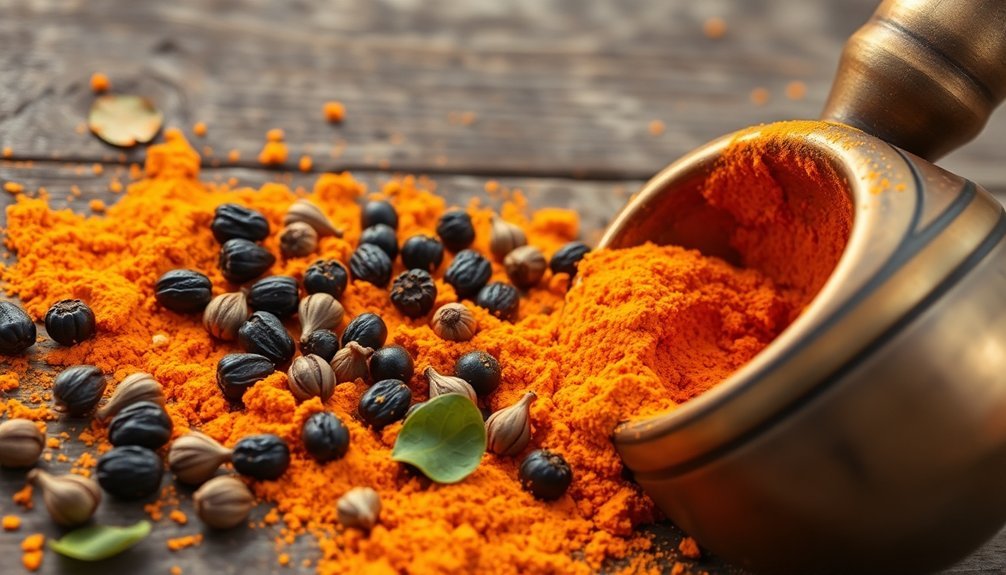Your favorite Indian spices do more than add flavor – they're natural preservatives that fight mold and bacteria. When you cook with traditional spices like clove, cinnamon, and turmeric, you're tapping into powerful antimicrobial compounds that have preserved food for thousands of years. These spices create hostile environments for harmful microbes by disrupting their cell membranes and growth patterns. In fact, 93% of traditional Indian recipes include at least one preservation-focused spice, with clove showing impressive bacteria-fighting power through its 21mm inhibition zone. There's a fascinating world of ancient wisdom and modern science behind your spice rack's protective powers.
Ancient Wisdom Behind Indian Spices

India's spice heritage represents one of humanity's earliest forms of food science. Through generations of careful observation and practice, ancient Indians discovered that certain spices could effectively preserve food while making it more flavorful.
Research shows that 93% of traditional recipes include at least one spice for preservation.
You'll find that this wasn't just a lucky coincidence – these spices were deliberately chosen for their powerful antiseptic and disinfectant properties.
What you mightn't realize is that this traditional knowledge aligns perfectly with modern scientific understanding. When you use spices like turmeric, clove, or black pepper in your cooking, you're actually following practices that evolved to protect against foodborne pathogens.
These spices don't just make your food taste better; they're actively fighting harmful microbes that could cause food spoilage or illness.
The genius of Indian cuisine lies in its complex spice combinations. You're not just adding random flavors when you combine multiple spices – you're creating powerful preservation systems that have been refined over thousands of years.
This ancient wisdom has been validated by Ayurvedic medicine, which recognizes how specific spice combinations can enhance both food safety and human health.
Most Powerful Antimicrobial Spices
A microscopic battle rages every time you add traditional Indian spices to your food. Among these natural defenders, clove emerges as the most potent warrior, creating an impressive 21mm zone where bacteria simply can't survive.
You'll find it's particularly effective against E. coli, making it a powerful food preservative. These spices have been proven effective through advanced preservation technologies that enhance their natural antimicrobial properties.
Black pepper, another antimicrobial powerhouse, proves especially effective against S. aureus with its 20mm inhibition zone.
What's particularly interesting is that it can outperform traditional antibiotics like Penicillin G against certain bacteria.
When you're looking to preserve meat, clove essential oils can reduce bacterial growth by an impressive 3.78 log CFU/g.
While cinnamon mightn't match clove's potency, it's still remarkably effective at preventing food spoilage, particularly in meat, fish, and dairy products.
You'll find it creates a 14mm zone of inhibition against common bacteria.
Cumin and carom seeds round out these antimicrobial champions, with carom's thymol content playing a vital role in fighting bacteria.
You'll notice cumin works particularly well against S. aureus, making it an excellent choice for meat preservation at low temperatures.
How Spices Fight Harmful Microbes

When you look at spices at a molecular level, you'll find they're packed with volatile and non-volatile compounds that act as nature's defense system against harmful microbes.
These bioactive chemicals can penetrate bacterial cell walls, disrupting their growth and reproduction through various mechanisms that include damaging cell membranes and interfering with metabolic processes. Ancient civilizations found that spice preservation techniques helped maintain food safety and quality.
You'll find these natural compounds working together in spices to create a powerful antimicrobial effect that's particularly effective against common foodborne pathogens like E. coli and S. aureus.
Chemical Compounds in Action
Three primary mechanisms define how spice compounds wage war against harmful microbes in food.
First, you'll find volatile compounds like essential oils that actively disrupt bacterial cell membranes. These compounds, found in cloves and cinnamon, fundamentally break down the protective walls of harmful microorganisms, leading to their death.
Second, you're getting powerful non-volatile compounds, such as polyphenols, that work alongside the essential oils. A perfect example is curcumin in turmeric, which doesn't just fight bacteria but also acts as an antioxidant to keep your food fresh longer.
When you combine different spices, you're creating a synergistic effect that's even more potent than using single spices alone.
Finally, you've got specific bioactive compounds that target different types of microbes. Eugenol in cloves can create inhibition zones up to 21mm against E. coli, while piperine in black pepper specifically targets certain bacteria.
These compounds are particularly effective against Gram-positive bacteria like Staphylococcus aureus, though they'll still fight Gram-negative bacteria too. The best part? These compounds remain stable even in complex food systems, making them reliable preservatives.
Nature's Defense System
Inside every pinch of Indian spices lies nature's sophisticated defense system against harmful microbes. When you add these spices to your food, you're actually deploying a broad-spectrum antimicrobial arsenal that targets various threats, from bacteria to molds and yeasts.
You'll find that spices like turmeric, clove, and cinnamon are particularly powerful defenders. They don't just prevent microbial growth – they actively disrupt the cell membranes of harmful organisms, leading to their destruction.
What's even more impressive is how these spices work together. When you combine different spices, you're creating a synergistic effect that enhances their protective properties.
The defense system remains stable even in complex food environments. Whether you're preserving meat, dairy, or vegetables, these spices maintain their effectiveness at various temperatures.
They'll fight off common threats like E. coli, Salmonella, and Staphylococcus while extending your food's shelf life. This isn't just modern science confirming what works – it's validating ancient Indian wisdom that has used these natural preservatives for thousands of years.
When you incorporate these spices into your cooking, you're tapping into nature's time-tested preservation method.
Traditional Indian Food Preservation Methods
The ancient wisdom of Indian food preservation has stood the test of time, combining scientific principles with cultural practices. You'll find that traditional methods like pickling, fermentation, and drying have been perfected over generations to keep food safe and flavorful for extended periods.
When you're pickling foods, you're utilizing an acidic environment created by vinegar or lemon juice, enhanced by mustard oil, turmeric, and fenugreek. These ingredients don't just add flavor; they're natural preservatives that protect your food from harmful microorganisms for months or even years.
You'll discover that fermentation isn't just for making idlis and dosas; it's a process that creates beneficial probiotics and makes nutrients more digestible.
Meanwhile, drying techniques, especially sun-drying, help you preserve seasonal ingredients like sewali phool and teeta phool for year-round use.
The role of spices extends beyond flavoring – they're nature's preservatives. You can use cinnamon to keep cooked rice fresh longer, while cumin, pepper, garlic, and ginger provide antimicrobial protection.
When you store these spices properly in dry, dark places, they'll maintain their preservative qualities and help protect your food from spoilage.
Science Meets Cultural Heritage

Modern scientific research has validated what Indian ancestors knew through centuries of culinary wisdom. The antimicrobial properties of spices like clove, cinnamon, and black pepper aren't just folklore – they're scientifically proven to fight against bacteria such as _E. coli_ and _S. aureus_. When you're cooking with traditional Indian spice blends, you're actually applying sophisticated food preservation techniques that have stood the test of time.
| Spice Property | Scientific Evidence |
|---|---|
| Antimicrobial | Creates inhibition zones against harmful bacteria |
| Antifungal | Prevents mold growth in foods like pickles and preserves |
| Bioactive Compounds | Contains alkaloids and glycosides that fight microbes |
| Volatile Oils | Provides natural preservation through essential oils |
| Synergistic Effects | Enhanced preservation when spices are combined |
You'll find that these preservation methods aren't just random – they're deeply rooted in regional variations and family traditions. The methanol extracts of spices like turmeric and ajwain have shown significant antimicrobial activity in laboratory testing, confirming what generations of Indian families have practiced through their unique spice blends and cooking techniques. This marriage of scientific validation and cultural heritage demonstrates why Indian cuisine has maintained its preservative properties for centuries.
Modern Applications of Spice Preservation
You'll find modern food industry giants incorporating traditional Indian spice preservation techniques into their large-scale operations, combining ancient wisdom with cutting-edge technology.
Through extensive research and development, companies are creating natural preservative systems that use spice extracts to replace synthetic additives while maintaining food safety and quality.
These innovations have revolutionized global supply chains, allowing preserved spices and spice-based products to reach markets worldwide while maintaining their potency and antimicrobial properties.
Food Industry Scale Applications
Food manufacturers worldwide have revolutionized preservation techniques by integrating traditional Indian spices into large-scale operations. You'll find these industrial applications combining ancient wisdom with modern technology, creating safer and longer-lasting food products while meeting consumer demands for natural preservation methods.
Today's food industry relies on sophisticated preservation systems that incorporate spices in multiple ways:
- Salt-based preservation methods, including encrusting and fermentation, work alongside traditional Indian spices like cumin and clove to create powerful antimicrobial barriers in meat and fish products.
- Vacuum packaging technology now pairs with spice-based preservation, allowing you to find naturally preserved foods that maintain their quality without artificial additives.
- Controlled environment storage facilities maintain precise conditions that maximize the preservative properties of spices like black pepper and mustard in various food products.
- Large-scale fermentation processes utilize beneficial microbes alongside spices, particularly in dairy and vegetable preservation, creating products that align with clean-label demands.
You'll notice this industrial-scale implementation of spice preservation particularly in processed foods, where manufacturers are responding to your growing preference for natural preservatives over synthetic alternatives.
Natural Preservative System Development
Building on industrial applications, natural preservative systems have evolved into sophisticated combinations of traditional wisdom and cutting-edge science.
You'll find today's preservation methods incorporating spice-infused oils, rubs, and brines that maximize the antimicrobial properties of ingredients like cloves, cinnamon, and black pepper.
When you're developing a natural preservative system, you can enhance its effectiveness by combining multiple spices. The synergistic effects of these combinations create stronger antimicrobial barriers against foodborne pathogens like Salmonella and Listeria.
You'll also benefit from the antioxidant properties of spices like ginger, turmeric, and oregano, which prevent fat oxidation and extend shelf life.
Modern technology has revolutionized how you can integrate these natural preservatives. You'll see advanced spice mills with automatic grinding and moisture sensors ensuring ideal preservation of volatile oils.
Whether you're using salt encrusting, fermentation, or combining spices with probiotics, you're tapping into a preservative system that's both effective and clean-label friendly.
These systems work particularly well when you're looking to meet consumer demands for minimally processed foods while maintaining food safety standards.
Global Supply Chain Integration
Through advanced technological integration, modern spice preservation has transformed into a sophisticated global network of precisely controlled processes. You'll find that today's spice industry combines traditional wisdom with cutting-edge technology to maintain the natural antimicrobial properties of Indian spices while guaranteeing consistent quality across international markets.
- When you're buying spices today, they've likely gone through advanced drying techniques like freeze-drying or vacuum drying, which preserve both their nutritional content and antimicrobial properties better than traditional sun drying.
- You can trust in the safety of your spices thanks to steam sterilization processes that eliminate harmful microorganisms without using chemicals or compromising the spices' natural preservative qualities.
- You'll benefit from optical sorting and smart packaging technologies that guarantee your spices remain pure and potent, with vacuum sealing and nitrogen flushing preventing oxidation and extending shelf life.
- You can now trace your spices' journey through blockchain technology, while data analytics optimize the supply chain to maintain quality from farm to table, supported by initiatives like the Sustainable Spices Initiative (SSI) and international certification standards.
Frequently Asked Questions
Can Spices Lose Their Antimicrobial Properties if Stored Incorrectly?
Yes, your spices can lose their antimicrobial properties if you don't store them properly. Exposure to moisture, light, oxygen, and improper handling will degrade their essential oils and active compounds over time.
How Do Different Cooking Methods Affect Spices' Ability to Fight Microbes?
You'll find that dry cooking methods best preserve spices' antimicrobial powers. While most spices remain stable at high heat, it's smart to add delicate herbs like cilantro after cooking to maintain their bacteria-fighting properties.
Are Organic Spices More Effective at Preventing Mold Growth Than Conventional Ones?
No, organic spices aren't more effective at preventing mold growth. In fact, you'll find they're often more susceptible to mycotoxin contamination due to the lack of synthetic fungicides used in organic farming practices.
What's the Minimum Concentration of Spices Needed for Effective Food Preservation?
You'll need at least 0.3% concentration of essential oils or 50-150 mg/L of active compounds for effective preservation. However, exact amounts vary by spice type and the food you're trying to preserve.
Do Powdered Spices Have the Same Antimicrobial Properties as Whole Spices?
Yes, you'll find that powdered spices maintain similar antimicrobial properties as whole spices. They're still effective because they retain their bioactive compounds, though the exact potency can vary based on processing methods.
In Summary
You've discovered the remarkable dual nature of Indian spices – they're not just flavor enhancers but natural preservatives backed by science. By incorporating these time-tested spices into your cooking, you'll tap into centuries of traditional food preservation wisdom. Whether you're using turmeric, clove, or cinnamon, you're carrying forward an ancient practice that modern research continues to validate as an effective way to keep food fresh and safe.





Leave a Reply